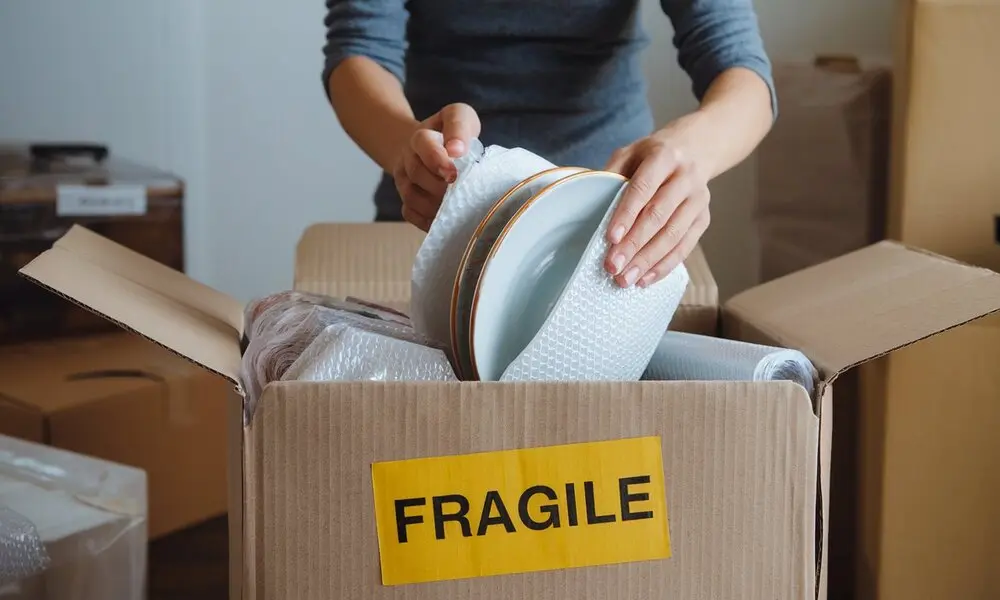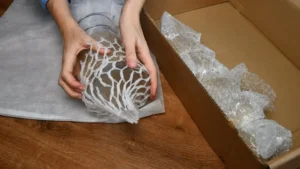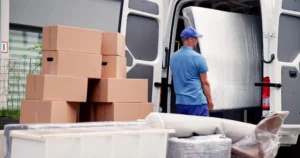How to pack dishes for moving without paper can feel like a daunting task, especially when you’re dealing with delicate and breakable kitchenware. Traditionally, many people have relied on newspapers to wrap their plates, bowls, and glasses, but this method comes with its own set of challenges like ink stains on your dishes and a considerable amount of paper waste.
As more people become conscious of their environmental impact, alternative methods for packing dishes without paper have gained popularity. These eco-friendly solutions not only help reduce waste but can also be just as effective, if not more so, at keeping your fragile items safe. Whether you’re using soft cloths, towels, or even clothing, packing dishes without newspaper is a practical and sustainable way to protect your kitchen essentials during a move.
Why Is Proper Dish Packing for Moving Important?
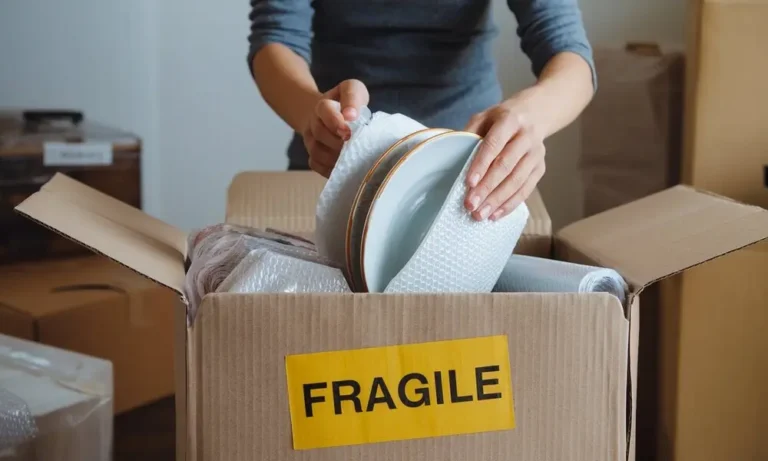
When it comes to packing dishes and packing plates to move, taking the time to do it right can save you money, stress, and heartache. Dishes are among the most fragile and frequently damaged items during a move, so careful packing is essential.
1. Preventing Breakage and Damage
Because they are fragile, dishes can quickly break, chip, or crack if they are not properly fastened. Using bubble wrap, packing paper, and sturdy boxes when packing plates to move creates a protective barrier that helps absorb shocks and vibrations during transit.
2. Cost and Sentimental Value of Dishes
Replacing broken dishes can be expensive—especially if you’re dealing with fine china or specialty sets. Even worse, some items hold sentimental value that can’t be replaced. When dishes are packed properly, they are guaranteed to arrive at your new house safely.
3. Reducing Stress During Unpacking
Unpacking dishes that were carefully packed is much easier and less stressful. You avoid the mess of broken items, and your kitchen can be set up more quickly and efficiently.
4. Good Packing vs. Rushed Packing
The difference between good and rushed packing is huge. Good packing involves planning, using the right materials, and ensuring items are tightly secured. Rushed packing often means tossing items into boxes with minimal protection, increasing the risk of damage.
For packing services in Los Angeles, contact the best, Chamomile Go.
Materials You Can Use Instead of Paper
While paper is a common choice for packing dishes, there are several reusable and eco-friendly alternatives that can offer just as much—if not more—protection. Here are some smart substitutes:
1. Soft Cloths, Dish Towels, or Tea Towels
These are perfect for wrapping individual plates and bowls. They save room by offering padding and being able to be packed with your kitchenware.
2. T-Shirts and Other Soft Clothing
Using soft clothing items like cotton T-shirts or leggings is a great way to pack plates to move while reducing the number of boxes needed for clothes.
3. Bubble Wrap (Reusable Option)
Though not the most eco-friendly, bubble wrap can be reused multiple times. It’s particularly useful for recipes that are particularly emotive or delicate.
4. Foam Plates or Cardboard Dividers
To stop chipping and scratches, sandwich ceramic plates with foam plates. Cardboard dividers work great for keeping glasses or mugs separated in a box.
5. Reusable Silicone or Fabric Wraps
Products like beeswax wraps or silicone mats can be molded around dishes for a snug fit, and used again in your new home.
How to Pack Dishes for Moving Without Paper
If you’re looking for an eco-friendly, efficient approach to packing dishes without paper, you’re in the right place. Using household items like cloths and clothing can protect your dishes just as well while cutting down on waste. Here’s a step-by-step guide:
1. Sort and Prepare Dishes
Spend some time doing the following before you begin packaging dishes without paper:
- Group similar items (e.g., plates with plates, mugs with mugs).
- To prevent packing broken parts, check each item for any chips or cracks.
2. Wrap Each Dish Securely
Instead of using packing paper:
- Use soft cloths, tea towels, T-shirts, or even socks to wrap each dish separately.
- For extra protection, double-wrap fragile objects, such as glassware or fine china, with a second layer of fabric or bubble wrap.
3. Layering and Box Setup
- Use folded towels or a small blanket to create a thick layer of padding at the bottom of the box.
- Place heavier dishes at the bottom, stacking lighter or more fragile items on top.
- Use foam plates, cardboard dividers, or rolled-up clothing between layers to prevent movement.
4. Seal and Label Clearly
- To reduce moving, stuff soft things into any empty spots in the box.
- Tape the box securely on all seams.
- To guarantee careful handling, clearly mark the box with “FRAGILE – DISHES” and indicate which side should be facing up.
You can also use our moving services in Los Angeles.
Four Step Dish Packing Guide Without Newspaper
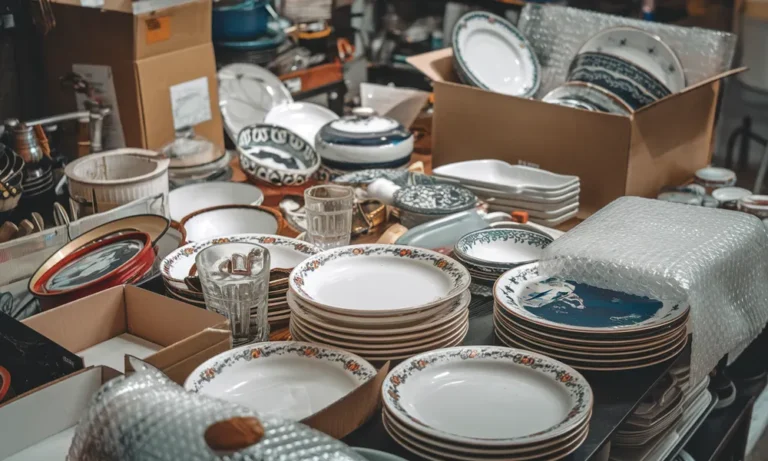
If you’re aiming to move your kitchen items safely and sustainably, this dish-packing guide without newspaper offers a clean and efficient solution. Ditch the ink-stained paper and use what you already have at home to protect your dishes the smart way.
Gather Alternative Wrapping Materials
Start by collecting soft, reusable items like dish towels, T-shirts, tea towels, or even scarves. These materials cushion your dishes well and can be reused at your new place—saving money and reducing waste.
Wrap Each Dish Individually
Cover each bowl, cup, and plate with a delicate coating of its own. Tuck the ends in securely, and for delicate items like glass or china, double up with an extra layer of fabric or a bit of bubble wrap if needed.
Pack Vertically with Padding and Layers
Use folded towels or a small blanket to provide padding along the bottom of the box. Place dishes on their edge (like records) rather than stacking them flat, which helps prevent breakage. To keep things snug, use garments or foam sheets in between layers.
Secure and Label the Box
Fill in any remaining gaps to stop items from shifting during the move. Once the box is full, seal it well with packing tape. Be sure to label it clearly with “FRAGILE – DISHES” and indicate which side should stay upright.
Final Thoughts
Packing dishes for a move without paper is not only eco-friendly but also practical when you use everyday items like cloths, towels, and clothing. Just remember to wrap each dish securely, layer with care, and label everything clearly. If you’re short on time or want extra peace of mind, hiring professionals can make all the difference.
Need expert help? For reliable dishes packing or moving and packing services in Los Angeles, contact Chamomile Go—your trusted moving partner. Get in touch with Chamomile Go today and let us take the stress out of your move!
FAQs
How Do I Pack Dishes For Moving Without Paper?
To pack dishes for moving without paper, you can use alternative materials such as kitchen towels, dish cloths, or even socks to cushion and protect your items. Wrap each dish individually in these soft fabrics to provide the necessary padding and reduce the risk of breakage.
What Materials Can I Use Instead Of Packing Paper For Dishes?
Instead of packing paper, consider using items you already have at home like towels, blankets, old t-shirts, or bubble wrap. These materials can offer a similar level of protection while being more environmentally friendly.
Is It Safe To Pack Dishes Without Paper?
Yes, it is safe to pack dishes without paper if you use the right materials for cushioning. Make sure to wrap each dish securely with soft fabrics like towels or dish cloths, and fill any empty spaces in the box with crumpled fabric or other soft materials to prevent movement.
How Do I Pack Fragile Dishes Without Paper?
For fragile dishes, take extra care by wrapping each piece in multiple layers of fabric or bubble wrap if available. Additionally, consider using small boxes for each dish or grouping them together based on size to ensure they fit snugly and don’t shift around during transport.
Can I Use Plastic Containers To Pack Dishes?
Yes, plastic containers or bins can be a great alternative for packing dishes. Just ensure you use enough padding around the dishes inside the containers to prevent them from shifting or knocking into each other during the move.
